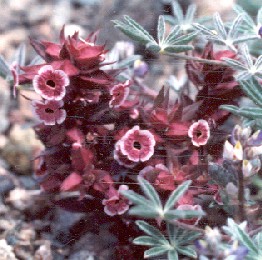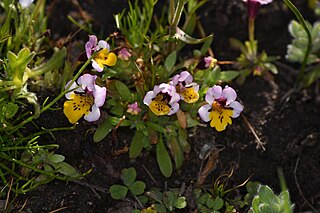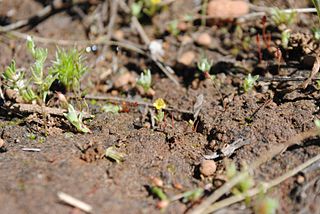| Lopseed family | |
|---|---|
 | |
| Erythranthe tilingii | |
| Scientific classification | |
| Kingdom: | Plantae |
| Clade: | Tracheophytes |
| Clade: | Angiosperms |
| Clade: | Eudicots |
| Clade: | Asterids |
| Order: | Lamiales |
| Family: | Phrymaceae Schauer |
| Genera | |
About 11; see text. | |
Phrymaceae, also known as the lopseed family, is a small family of flowering plants in the order Lamiales. [1] It has a nearly cosmopolitan distribution, but is concentrated in two centers of diversity, one in Australia, the other in western North America. [2] Members of this family occur in diverse habitats, including deserts, river banks and mountains.
Contents
Phrymaceae is a family of mostly herbs and a few subshrubs, bearing tubular, bilaterally symmetric flowers. They can be annuals or perennials. [2] Some of the Australian genera are aquatic or semiaquatic. One of these, Glossostigma, is among the smallest of flowering plants, larger than the aquatic Lemna but similar in size to the terrestrial Lepuropetalon . The smallest members of Phrymaceae are only a few centimeters long, while the largest are woody shrubs to 4 m tall. The floral structure of Phrymaceae is variable, to such an extent that a morphological assessment is difficult. Reproduction is also variable, being brought about by different mating systems which may be sexual or asexual, and may involve outcrossing, self-fertilization, or mixed mating. Some are pollinated by insects, others by hummingbirds. The most common fruit type in this family is a dehiscent capsule containing numerous seeds, but exceptions exist such as an achene, in Phryma leptostachya , or a berry-like fruit in Leucocarpus.
About 16 species are in cultivation. [3] They are known horticulturally as "Mimulus" and were formerly placed in the genus Mimulus when it was defined broadly to include about 150 species. Mimulus, as a botanical name, rather than a common name or horticultural name, now represents a genus of only seven species. Most of its former species have been transferred to Diplacus or Erythranthe. [2] Six of the horticultural species are of special importance. These are Diplacus aurantiacus, Diplacus puniceus, Erythranthe cardinalis, Erythranthe guttata, Erythranthe lutea, and Erythranthe cuprea .
Phrymaceae has recently become a model system for evolutionary studies. [4]
Within the order Lamiales, Phrymaceae is a member of an unnamed clade of five families. [5] This clade has the topology of a phylogenetic grade and can therefore be represented as {Mazaceae [Phrymaceae (Paulowniaceae <Orobanchaceae + Lamiaceae>)]}. [6] Two of these families, Mazaceae and Rehmanniaceae are not part of the APG III system. [7] They were not formally validated until 2011. [8]
The composition of Phrymaceae and the delimitation of genera changed radically from 2002 to 2012 as a result of molecular phylogenetic studies. [9] [10] [11] Previously, Phrymaceae had been monotypic with Phryma leptostachya as its only species. It was limited in geographic range to eastern North America and eastern China. Phryma had been previously placed by Cronquist in Verbenaceae. Research on phylogenetic relationships revealed that several genera, traditionally included in Scrophulariaceae, were actually more closely related to Phryma than to Scrophularia . [12] These genera became part of an expanded Phrymaceae. Mazus and Lancea were included in Phrymaceae for a short time before further studies indicated that they, along with Dodartia should be segregated as a new family, Mazaceae.
As currently understood, Phrymaceae consists of about 210 species in 13 genera. [2] Erythranthe (111 species) and Diplacus (46 species) are much larger than the other genera. Phrymaceae is distributed nearly worldwide but with the majority of species in western North America (about 130 species) and Australia (about 30 species). Phrymaceae consists of four clades, all of which have strong statistical support in cladistic analyses of DNA sequences. No relationships among these four clades have been strongly supported by the bootstrap or posterior probability assessments of clade support in any of the datasets that have been produced so far. One of the four main clades consists of a single species, Phryma leptostachya . Another consists of Mimulus sensu stricto (seven species) and six genera that have an Australian distribution. The other two clades have an American-Asian disjunct distribution. [13] One of these includes the large genus Diplacus, while the other of these includes the other large genus, Erythranthe.
Estimates of the number of species in Phrymaceae have varied widely because of a lack of clear differences between species in certain genera, especially Diplacus and Erythranthe. When these two genera have been treated as segregates of Mimulus, the number of species assigned to Mimulus sensu lato has ranged from about 90 [14] to about 150. [15] A 2008 paper indicates that the actual number of species is well over 150. [4]
In 2012, a revision of Phrymaceae recognized 188 species in the family, but noted that 17 species from Australia and five from North America would be named and described in future publications. Ten of those unnamed species will be in Peplidium , raising the number of species in that genus from four to 14. [2]














